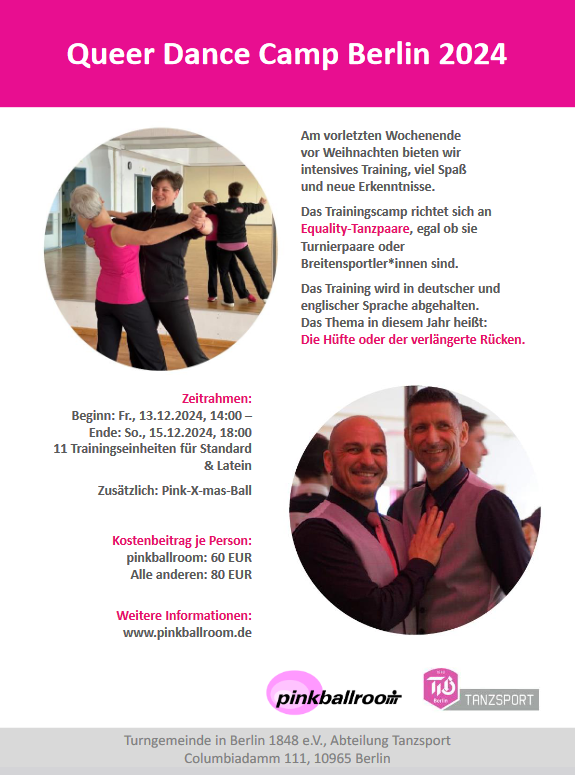Gergely Darabos
He started his dancing career in Budapest and danced since 2001 regularly at national and international Equality tournaments. With different partners he gained beneath other titles the world champion of 10 dances in the years 2006 and 2010. At the Equality dance floor he unfortunately lacks in the last years, but on the „mixed“ floor he won the German title in Combination SEN I. Since 2007 he trains at pinkballroom with a lot of commitment and excellent ideas– one of them the Queer Dance Camp – different groups in ballroom & latin. He es trainer and choreographer of our latin show-group “pink unicorns”, the actual German Champion. Since September 2017 he has the trainer B liscence.
About the training: rotations in Viennese waltz & Paso Doble
Pascal Herrbach
Pascal started in younger ages with dance competitions in the straight sector and has already there been very successful (e.g. German champion junior ballroom 1993). Since 2000 he can nearly only be seen on the equality dance floor. No other male equality ballroom dancer possesses such an impressive success balance. Together with Christian he became the first official world champions Equality men ballroom in the year 2013 at the Outgames in Antwerp. With different partners he collected several titles at the Gay and OutGames in ballroom., latin and 10 dances. He is training couples at pinkballroom for long years on basis of his deep knowledge and experience as Equality dancers.
About the Training: In Latin Pascal will focus on samba promenades as a basic figure, for which it is essential to rotate at the good moment and not to rotate at the other ones. He will combine it with the possibility to change the lead surprisingly. In ballroom he will talk about rotation in slow fox and the possibility to create smooth and easy movements with correct body rotation.
Margaryta Vyshetravska
With the age of 5 years she began to dance – first in Ukraine and later in Hungary. She has been finalist in different open IDSF tournaments. Now she changed the party and evaluates other couples as WDC adjudicator – and in the last years especially at Equality tournaments. 2004 she started to work as a trainer and since 2006 she trains same sex couples in Hungary. The success of the Hungarian couples in Latin is not least reasoned by her professional training.
About the Training: Rotation is one of my favorite topic. It is not so easy, but if you can use it in the dance, in turns it makes fantastic feelings, how quick can you be and how comfortable is everything. We will speak about rotation in our body, in the couple ( leading) and of course in turns.
Christian Wenzel
Meanwhile 20 years ago Christian started with dancing as a young adult and immediately in the Equality sector. Only later on basis of this experience he started with straight competitions. Before his dancing with Pascal he could gain a lot of national and international successes with different partners, not only in ballroom but as well in latin. He is training couples for 20 years between other at the conTakt Düsseldorf on basis of his intensive examination of Equality dancing.
About the training: Christian will focus on the correct rotation for promenade positions. For this he will use basic choreographies in Tango and Jive. Which rotations do we need for the “opening“ into the promenade (and which not) and how do we “close“ (and not topple over) again?
Caroline Privou & Petra Zimmermann
There is no couple in the long one 😉 history of the same-sex dance sport that dominate its section (standard) so uninterruptedly as Petra & Caroline. Since 2002 they have won every tournament at which they started. That means alone 15 gold medals at the Berlin Open, plus 9 world championship titles and …. And …. With keywords like „unbeatable“ or „a class for itself“ they are often announced. From dancers for dancers they will impart their knowledge to us, hopefully we can also apply it a little successfully;-).
About the Training: The essence in Ballroom dancing is about two people moving together as one, in time to musical interpretation. This element of moving together is one of the most challenging to master. We can easily manage dynamic rotational forces on our own bodies, but when another body is added to the mix things that seem effortless suddenly become surprisingly difficult. Why is that and what can we do to prevent common faults that result in the disharmony (disconnection) of the couple? To help dancers create a better connected movement in their dance we will use basic figures and your choice of choreography in Slow Waltz and Quickstep and focus on:
• There is no movement without rotation – true or false?
• Why do we need to rotate?
• What are the rotational characteristics of right/left turning figures?
• What is the inside/outside of a turn and why do we use of pointing steps?
• What different kinds of rotations (moving-circular-internal rotations) are needed to create a smooth & together movement in closed,- and outside partner positions as well as promenade positions?
• How do we use head weight in rotational movements ?
Guido Bouwmann
He himself has danced high-class ballroom and latin for years. In 1998 he retired from active tournament sport and since then has been teaching ballroom for our competition and leisure sport groups – especially also for pinkballroom. The couples appreciate his positive and individual support in training and his profound knowledge. He is also active as a competition manager and DJ in equality dancing and as a DTSA examiner in popular sports.
About the training: rotations in slow fox
Back to the main page Queer Dance camp

